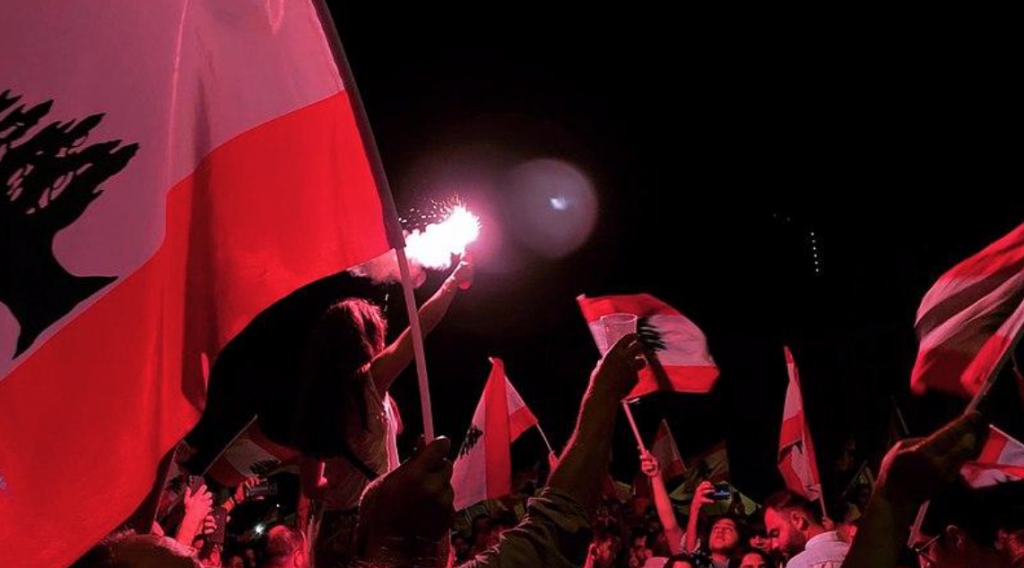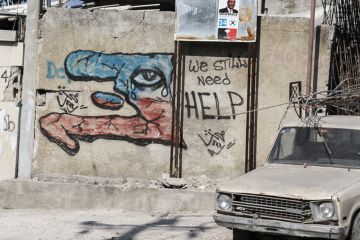
“Flare shines light in group of passionate Lebanese protesters” by Jessica Wahab, 10 November 2019, CC BY-SA 4.0.
The Tipping Point
Since October 17th, thousands of Lebanese citizens have been flooding the nation’s city centers in peaceful protest of long-standing government corruption, growing inequality, sectarianism, and poor provision of public services [1].
Lebanese citizens are by now familiar with frequent electricity shortages, poor sanitation services, and crumbling infrastructure [2]. Though taxes continue to rise, little of the revenue seems to go toward improving public services. Growing anger with this state of affairs was brought to a tipping point by a new set of proposed taxes, especially the notorious “WhatsApp tax” [3], now a symbol of government corruption. Protestors were also mobilized by the regime’s disastrously slow response to a series of forest fires that began on October 13th [4], revealing the depths of government mismanagement.
Civil Society
Despite retaliation from the Lebanese regime [5], the scale of this month’s protest has shown a remarkable capacity for assembly in Lebanon, a salient reminder of the importance of civil society in the fight for economic, social, and political equality.
By encouraging civic engagement and enabling individuals to collectively hold their governments to account, civil society can create a political climate that fosters the growth of democracy. Lebanon’s civil society has been described as “among the most vibrant in the Middle East” [6]. Yet, substantive democracy has not followed, with politicians as far back as the 1980s remarking that “the system has always had plenty of freedom but suffered from a lack of democracy” [7].
For the People?
This is because democracy in Lebanon is limited by the clientelism and sectarianism which governs politics. Today’s sectarianism was outlined in the 1989 Taif agreement [8]. Written with the purpose of ending the Lebanese Civil War, this agreement limits the influence of elite Maronite Christians who had previously dominated politics and delegates powers between the largest three sects (Maronite Christians, Shi’a Muslims, and Sunni Muslims).
Though designed to give each religion relative power, sectarianism has instead given rise to clientelism, a system in which religious leaders dole out favours for political support, civic positions are given to friends of elites, and bribery thrives [9]. Under sectarianism, political disagreements are inherently religious, and quickly become personal, making party differences extremely hard to overcome.
In such a regime, parties do not seek only electoral success. Instead, competitions can occur “outside of formal institutionalized channels” with parties “[struggling] over the basic rules of allocating power” [10], which slows down decision-making and intensifies conflicts. By institutionalizing religious differences and allowing corruption, Lebanon’s legislative process has become an inefficient one, in which basic laws take years to pass and elections are a laborious ordeal.
The Economy of Lebanon
Mismanagement in government has also led to a series of economic mistakes. Lebanon takes out an exorbitant amount of loans, including from their own banks, who mark them with heavy interest rates [11]. As a result, Lebanon has a proportionally massive debt, valued at around 155% of the nation’s GDP, the third-worst ratio of this kind in the world [12].
Corruption, the inefficiency of sectarianism, and a faltering economy have led to a chasm of inequality. “Based on income tax figures, the richest 1 percent of Lebanon’s population claimed 25 percent of the total national income between 2005 and 2014” [13], reads one report. This inequality, and a lack of growth, is leading the students who can afford it to study and work abroad, causing a drain of human capital that is well-known to many nations with stagnant economies. Those who remain make up a large proportion of the current protestors, fighting for a more livable future.
A New Kind of Protest
The demands of these protestors are multifold, with calls for political and social reforms. Others target the national debt and growing unemployment. The solution for many seems to be total overhaul; with chants of “all of them means all of them” [14]demanding the removal of all government elites from their positions.
What unites the protestors, however, is resentment for sectarianism and corruption, the forces which have stagnated the economy and exacerbated inequality. So uniting are these sentiments that this month’s protests are among the first in Lebanon to completely cut across sect lines. It has been noted by academics that “a shift in the Lebanese political system… to a secular one would contribute greatly to the decline of clientelism” [15], making this dismissal of sectarianism a cause for great hope.
Outlook for the Future
Though it would be premature to attempt to predict the impact of these demonstrations, there are already signs of change. The resignation of Prime Minister Saad Hariri[16], for example, is only an early step, but this month of all-encompassing revolution may be a building block toward jettisoning sectarianism in favour of an effective and representative political system. One protestor remarked, “People are realising that a Christian living in extreme poverty is no different from a Sunni or Shia living in extreme poverty” [17], indicating a shift away from religious division and toward collective action.
Hopefully, the strong civil presence in Lebanon will not waste this momentum. Their success could mean a better regime is on the horizon, one in which talented youth feel hopeful for their future and public services are provided to all citizens, no matter their position. After all, as these protests have made clear, the people of Lebanon already know that a government that does not work for everybody, works for nobody.
Edited by Ghayas Osseiran
References
1. Martin Patience, “Lebanon protests: A country feeling reborn”, 22 October 2019, BBC News, https://www.bbc.com/news/world-middle-east-50139850.
2. Hannes Baumann, “Lebanon’s economic crisis didn’t happen overnight. So how did it get to this point?”, 22 October 2019, The Washington Post, https://www.washingtonpost.com/politics/2019/10/22/lebanons-economic-crisis-didnt-happen-overnight-so-how-did-it-get-this-point/.
3. Martin Patience, “Lebanon protests: A country feeling reborn”.
4. Hannah Brown “Wildfires are raging in Lebanon. Experts say they saw this coming.”,17 October 2019, Vox, https://www.vox.com/2019/10/17/20916314/lebanon-fires-experts-saw-it-coming.
5. “Lebanon Protests Explained”, n.d., Amnesty International, https://www.amnesty.org/en/latest/news/2019/11/lebanon-protests-explained/.
6. David Schenker, “Lebanon’s [Un]Civil Society”, March 2016, The Washington Institute, https://www.washingtoninstitute.org/policy-analysis/view/lebanons-uncivil-society.
7. Hassan Krayem, “The Lebanese Civil War and the Taif Agreement”, n.d., American University of Beirut, http://ddc.aub.edu.lb/projects/pspa/conflict-resolution.html
8. Anchal Vohra, “The Arab World’s Revolution Against Sectarianism,” 24 October 2019, Foreign Policy, https://foreignpolicy.com/2019/10/24/lebanon-iraq-arab-world-wants-to-overthrow-sectarianism/.
9. Hannes Baumann, “Lebanon’s economic crisis didn’t happen overnight. So how did it get to this point?”.
10. Melani Cammett and Sukriti Issar, “Bricks and Mortar Clientelism: Sectarianism and the Logics of Welfare Allocation in Lebanon,” World Politics 62, no. 3 (2010): 381-421, www.jstor.org/stable/40891382.
11. Hannes Baumann.
12. Hannes Baumann.
13. Nisreen Salti, “No Country for Poor Men: How Lebanon’s Debt Has Exacerbated Inequality”, 17 September 2019, Carnegie Middle East Center,
14. “Lebanon Protests Explained”, n.d., Amnesty International.
15. Hamzeh, A. Nizar. “Clientalism, Lebanon: Roots and Trends.” Middle Eastern Studies 37, no. 3 (2001): 167-78. www.jstor.org/stable/4284178.
16. Vivian Yee. “Lebanon’s Prime Minister, Saad Hariri, Steps Down in Face of Protests”, 29 October 2019, New York Times, https://www.nytimes.com/2019/10/29/world/middleeast/saad-hariri-stepping-down-lebanon.html. Lebanon’s Prime Minister, Saad Hariri, Steps Down in Face of Protests
17. Martin Patience, “Lebanon protests: A country feeling reborn”.




